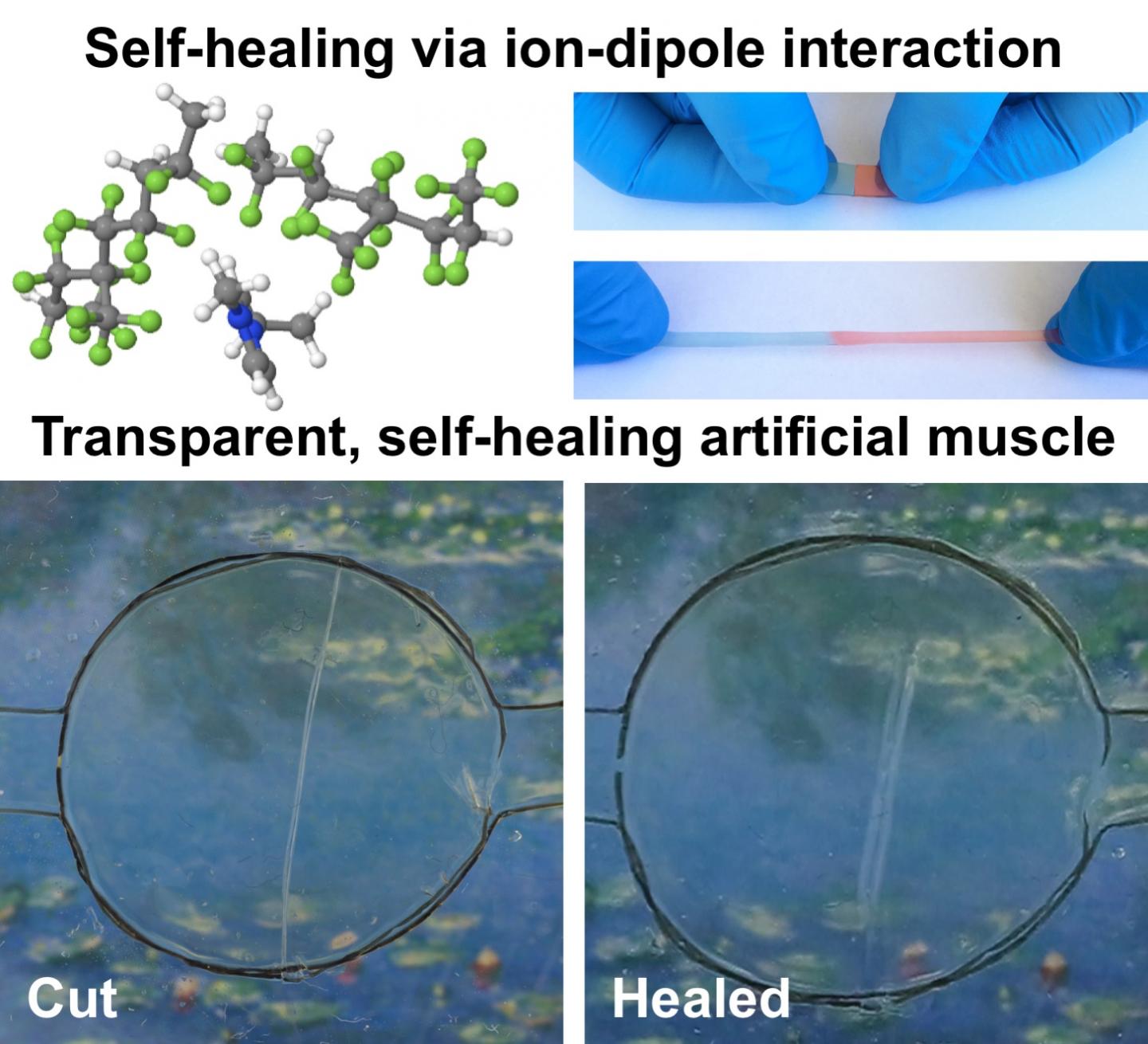A transparent, self-healing, highly stretchable conductive material
January 6, 2017

This illustration shows use of an ion-dipole interaction and self-healing material. (credit: University of Colorado, Boulder)
A team of scientists has developed a transparent, self-healing, highly stretchable conductive material that can be electrically activated to power artificial muscles or used to improve batteries, electronic devices, and robots.
The findings, published Dec. 23 in the journal Advanced Materials, combine the fields of self-healing materials and ionic conductors (a material that ions can flow through). Ionic conductors are a class of materials with key roles in energy storage, solar energy conversion, sensors, and electronic devices.
The material has potential applications in a wide range of fields. It could give robots the ability to self-heal after mechanical failure, extend the lifetime of lithium ion batteries used in electronics and electric cars, and improve biosensors used in the medical field and environmental monitoring, the scientists say.
Inspired by wound healing in nature, the idea for self-healing materials is to repair damage caused by wear, lower the cost of materials and devices, and extend their lifetime.
“Creating a material with all these properties has been a puzzle for years,” said Chao Wang*, a University of California, Riverside adjunct assistant professor of chemistry who is one of the authors of a paper published in December in Advanced Materials.
Another author of the paper, Christoph Keplinger, an assistant professor at the University of Colorado, Boulder, previously demonstrated that stretchable, transparent, ionic conductors can be used to power artificial muscles and to create transparent loudspeakers — devices that feature several of the key properties of the new material (transparency, high stretchability, and ionic conductivity).
Limitations of current self-healing polymers
Conventionally, self-healing polymers make use of non-covalent bonds, which creates a problem because those bonds are affected by electrochemical reactions that degrade the performance of the materials.

Design concept for a transparent, self-healing, highly stretchable ionic conductor using ion–dipole interaction (credit: Yue Ca et al./Advanced Materials)
Wang helped solve that problem by using a mechanism called ion-dipole interactions, which are forces between charged ions and polar molecules that are highly stable under electrochemical conditions. He combined a polar, stretchable polymer with a mobile, high-ionic-strength salt to create the material with the desired properties.
The soft rubber-like material they created is low-cost, easy to produce, and can stretch 50 times its original length. After being cut, it can completely re-attach, or heal, in 24 hours at room temperature. (After only five minutes of healing, the material can be stretched two times its original length.)
Artificial muscles
The scientists demonstrated that the material could be used to power an artificial muscle, or dielectric elastomer actuator. “Artificial muscle” is a generic term used for materials or devices that can reversibly contract, expand, or rotate due to an external stimulus such as voltage, current, pressure or temperature.
The dielectric elastomer actuator is actually three individual pieces of polymer that are stacked together. The top and bottom layers are the new material developed at UC Riverside, which is able to conduct electricity and is self-healable, and the middle layer is a transparent, non-conductive rubber-like membrane.
The researchers used electrical signals to get the artificial muscle to move. So, just like how a human muscle (such as a bicep) moves when the brain sends a signal to the arm, the artificial muscle also reacts when it receives a signal.
Most importantly, the researchers were able to demonstrate that the ability of the new material to self-heal can be used to mimic a preeminent survival feature of nature: wound-healing. After parts of the artificial muscle were cut into two separate pieces, the material healed without relying on external stimuli, and the artificial muscle returned to the same level of performance as before being cut.
* Wang developed an interest in self-healing materials because of his lifelong love of Wolverine, the comic book character who has the ability to self-heal.
Abstract of A Transparent, Self-Healing, Highly Stretchable Ionic Conductor
Self-healing materials can repair damage caused by mechanical wear, thereby extending lifetime of devices. Here, a transparent, self-healing, highly stretchable ionic conductor is presented that autonomously heals after experiencing severe mechanical damage. The design of this self-healing polymer uses ion–dipole interactions as the dynamic motif. The unique properties of this material when used to electrically activate transparent artificial muscles are demonstrated.